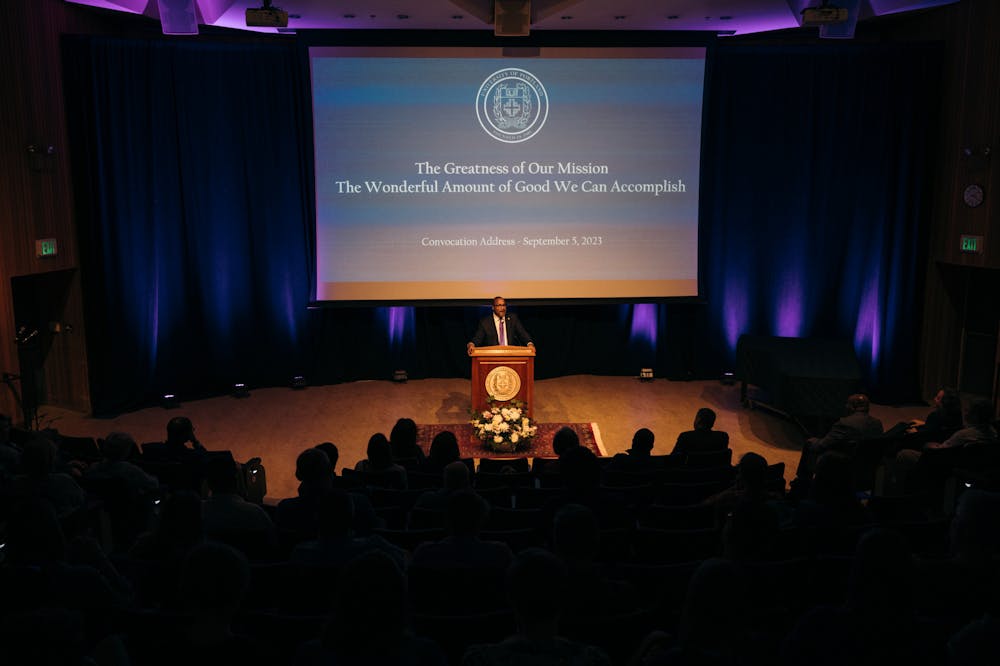Facing declining enrollment and a $10 million budget shortfall, UP is launching its biggest fundraising campaign yet, according to President Robert Kelly.
In his convocation speech before faculty and staff on Tuesday, Sept. 5 in the Buckley Center Auditorium, he outlined UP’s financial challenges while also introducing ambitious plans, including a new Student Welcome and Engagement Center for the parcel where the Pilot House now sits.
Here are the key points from his address.
Financial Challenges
Much of Kelly’s speech covered UP’s financial troubles. Due to another year of low enrollment for fall semester, the University is $10 million short — about 7% — of its budget.
Because UP depends on revenue from tuition, room and board to survive, years of decreased enrollment since the COVID-19 pandemic have caused significant financial strain. According to Kelly, there are 753 students in this year’s freshman class. This is 60 fewer than last year, a low-enrollment year that caused widespread budget cuts. For perspective, in fall of 2019 — before the onset of the pandemic — UP’s first-year class was 1003 students, according to institutional research.

Mai Nhia Xiong-Chan joins UP as the Inaugural Vice President for Enrollment Management. Photo courtesy of Dan Christopherson.
As UP tries to climb out of this financial slump, Kelly wants to see enrollment increase to anywhere between 900 and 950 students per undergraduate class. Mai Nhia Xiong-Chan will serve as vice president of enrollment management, a new role Kelly has created as part of the enrollment effort. There will also be efforts to increase graduate enrollment.
What’s more, the university’s otherwise high retention rate is expected to drop from last semester’s 86%. One effort to
increase retention is the new requirement that students spend two years minimum living on campus. On-campus housing increases tuition revenue and is expected to foster the community engagement needed to strengthen retention.
Most students don’t pay full tuition. Instead, they pay a discounted price after scholarship and grant awards. This is what the discount rate is capturing. When the discount rate is higher, students pay on average a lower percentage of the university’s full tuition, or “sticker price.”
For example, the current rate is 54% (up from last year’s 51% and the pre-pandemic rate of 46%). In this case, first year students are paying on average 46% of full tuition.
But with the discount rate up and enrollment down, this means there are less students — and they’re paying less money.
A financial town hall featuring Vice President for Financial Affairs Eric Barger will be held in October to address the budget issues in depth, Kelly said.
Fundraising Campaign
Kelly is moving forward with an ambitious fundraising campaign. While it may also alleviate some of UP’s financial challenges, Kelly believes the campaign is crucial whether or not such challenges exist.
“We have a vision of the university and we're not content to rest on our laurels,” Kelly said. “I’m excited about what we will be able to accomplish together as a part of this campaign, which will be the largest in our university’s history.”
The primary focus of the campaign will be broadening access to The Bluff by expanding scholarship opportunities. Other campaign goals include raising money for faith and justice work, supporting faculty and strengthening operations.
“We simply cannot cut our way to sustainability,” Kelly said. “We must find ways to re-invest.”
Welcome and Engagement Center
Another focus of the fundraising campaign is building the Welcome and Engagement Center, which would house The
Moreau Center, Campus Ministry, Student Activities and Clubs, ASUP, Student Media, dining services, common
spaces and the Office of Admissions. Kelly said the Pilot House will be torn down to make space for

the new building, which would be the hub for groups currently operating out of St. Mary’s Student Center.
“The time has come to sunset St. Mary’s and build a structure that is truly worthy of our students,” Kelly said.
So far, ASUP has gifted $375,000 in seed money for the project. Kelly emphasized that UP wouldn't begin building until all necessary funds are raised.
“Critically, I want to ensure that the campus will not put shovels in the ground until the building is fully funded,” Kelly said.
Academics
The fundraising campaign will also encompass academics.
UP has been given a grant by the Come to Believe Network to explore launching a two-year degree program. The network’s model is aimed at accessibility for groups that are often underrepresented in higher education. For now, the program will remain under study.
In addition, two new majors (arts administration and biochemistry) and minors (exercise science and medical Spanish) have been created. More information can be found on UP’s undergraduate programs page.
Riley Martinez is Copy Editor for The Beacon. He can be reached at martini24@up.edu









